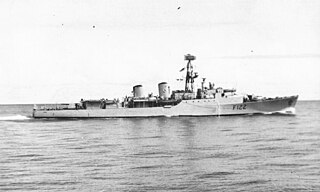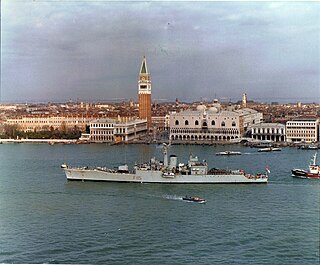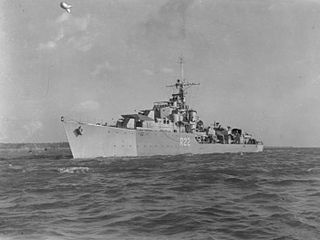
HMS Lynx (F27), was a Leopard-class Type 41 anti aircraft frigate of the British Royal Navy, named after the lynx.

The Battle class were a class of destroyers of the British Royal Navy (RN) and Royal Australian Navy (RAN), named after naval or other battles fought by British or English forces. Built in three groups, the first group were ordered under the 1942 naval estimates. A modified second and third group, together with two ships of an extended design were planned for the 1943 and 1944 estimates. Most of these ships were cancelled when it became apparent that the war was being won and the ships would not be required, although two ships of the third group, ordered for the RAN, were not cancelled and were subsequently completed in Australia.

HMS Gurkha (F122) was a Tribal-class frigate of the Royal Navy. She was named after an ethnic group located in Nepal, and who continue to serve in the British Army. She was sold to the Indonesian Navy in 1984 and renamed KRI Wilhelmus Zakarias Yohannes (332).

The Weapon class was a class of destroyers built for the British Royal Navy towards the end of World War II. They were the smaller counterpart to the Battle class and were the first new destroyer designs for the Royal Navy since the Second World War Emergency Programme. 20 ships were planned, of which only 13 were laid down and 7 were launched, but the cessation of hostilities resulted in only 4 being completed for service. Two of the ships had been previously ordered as part of the planned C class, or 15th Emergency flotilla, of 1944, but the orders were changed to the new design.

The C class was a class of 32 destroyers of the Royal Navy that were launched from 1943 to 1945. The class was built in four flotillas of 8 vessels, the "Ca", "Ch", "Co" and "Cr" groups or sub-classes, ordered as the 11th, 12th, 13th and 14th Emergency Flotillas respectively. The sub-class names are derived from the initial 2 letters of the member ships' names, although the "Ca" class were originally ordered with a heterogeneous mix of traditional destroyer names. A fifth flotilla, the "Ce" or 15th Emergency Flotilla, was planned but were cancelled in favour of the Weapon-class destroyers after only the first two ships had been ordered. The pennant numbers were all altered from "R" superior to "D" superior at the close of World War II; this involved some renumbering to avoid duplications.

HMS Yarmouth was the first modified Type 12 frigate of the Rothesay class to enter service with the Royal Navy.

HMS Grenville was the second ship of this name to serve with the Royal Navy in the Second World War. Grenville and seven other U-class destroyers were ordered as part of the Emergency Programme. She was launched at Swan Hunter and Wigham Richardson Ltd., Wallsend-on-Tyne on 12 October 1942 and commissioned on 27 May 1943.

HMS Rothesay was the lead ship of the Rothesay or Type 12M class of anti-submarine frigates of the British Royal Navy. She was commissioned in 1960 and scrapped in 1988.

HMS Londonderry was a Rothesay- or Type 12-class anti-submarine frigate of the British Royal Navy in service from 1960 to 1984.

HMS Falmouth was a Rothesay-class, or "Improved Type 12", anti-submarine frigate built for the Royal Navy during the 1950s. She took part in the Third Cod War in 1976, ramming the Icelandic gunboat V/s Týr. Both ships suffered extensive damage.

HMS Berwick was a Rothesay- or Type 12I-class anti-submarine frigate of the British Royal Navy. She was built by Harland & Wolff and launched on 15 December 1959.
HMS Leopard (F14), was a Leopard-class Type 41 anti aircraft frigate of the British Royal Navy, named after the leopard.

HMS Broadsword was a Weapon-class destroyer of the British Royal Navy in service from 1948 and scrapped in 1968.

HMS Undaunted was a U-class destroyer of the British Royal Navy that saw service during World War II. She was later converted into a Type 15 fast anti-submarine frigate, with the new pennant number F53.

HMS Ursa was a U-class destroyer of the Royal Navy that saw service during the Second World War. She was later converted into a Type 15 fast anti-submarine frigate, with the new pennant number F200.

HMS Wrangler was one of eight W-class destroyers built for the Royal Navy during World War II. Completed in 1944, the ship spent most of the war in the Far East and escorted British aircraft carriers as their aircraft attacked targets in the occupied Dutch East Indies and in Japan itself. Wrangler was present in Tokyo Bay when the Japanese formally surrendered on 2 September 1945.

HMS Wakeful was a W-class destroyer of the Royal Navy launched in 1943. She saw service during the Second World War and was later converted into a Type 15 fast anti-submarine frigate. She was sold for scrap in 1971.

The Impavido class were the second group of destroyers built for the Italian Navy after World War II and the first Italian guided missile destroyers. Similar in performance to the US Navy's Charles F. Adams class, these ships were essentially improved Impetuoso-class vessels, with the after gun-turret being replaced by a Tartar surface-to-air-missile launcher and associated radar.

The T 47 class or Surcouf class were the first destroyers built for the French Navy after the Second World War. Twelve ships were built between 1955 and 1957. The ships were modernised in the 1960s and decommissioned in the 1980s, when they were replaced by the Cassard and Georges Leygues-class frigates. The class was authorised in 1949 and were designed as aircraft carrier escort vessels. Three were modified to become flagships, four became anti-air guided missile destroyers and five became anti-submarine destroyers. One member of the class survives, Maillé-Brézé as a museum ship at Nantes.

The Dealey-class destroyer escorts were the first post-World War II escort ships built for the United States Navy.



















